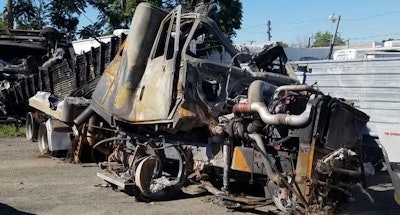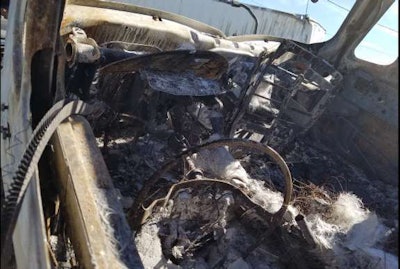The events of June 29, 2016, are etched in truck driver Belinda Blacketer’s mind. It started out simply enough — she was coming off her break on a run she had made countless times. She’d taken a familiar shortcut on State Road 14 in Washington as she headed to her next stop, but that was the last thing typical about that day.
 Belinda Blacketer’s truck she called “Girly” before the accident
Belinda Blacketer’s truck she called “Girly” before the accidentAs she drove down the two-lane highway, Blacketer noticed an oncoming white sedan driving erratically, crossing into her lane and then back into its own. She slowed and edged over to give the driver more space, but the sedan swerved sharply and slammed into the front of her truck.
 “Girly” after the accident in 2016
“Girly” after the accident in 2016The impact caused the front of the truck to go airborne while the steering wheel spun freely. While she was still in the air, Blacketer heard the “phoof” of the engine catching on fire. After the truck landed and came to a stop, flames blocked her way out of the driver’s-side door, so she quickly unbuckled her seatbelt and fled through the passenger’s side. She escaped with only what she was wearing, save one shoe that she lost while exiting the truck.
 “Girly’s” driver seat from which Belinda Blacketer escaped
“Girly’s” driver seat from which Belinda Blacketer escapedSafe on the other side of the highway, Blacketer watched her 2010 International ProStar, which she called “Girly,” burn to the ground along with all her belongings and the trailer. The truck was only two weeks from being paid off. The driver of the white sedan was pronounced dead when the authorities arrived, and the police report from the crash noted he had a blood alcohol level that was more than twice the legal limit, along with a significant amount of cocaine in his system.
“It didn’t affect me right away,” Blacketer says. “When I was in the middle of it, my brain went into the more clinical, technical part of it. My brain went into the step by step by step — get yourself out this, get away from it. That’s pretty much the mindset I went into on scene, and pretty much that night and throughout the next day. The next day I had to replace my phone, there were things I needed to do, so I went down the list of steps I needed to take so that I could get back on track. It wasn’t until a couple of days later that it really slammed into me, as far as holy s**t, this thing almost killed me.”
After a long pause, Blacketer added, with a catch in her voice, “I think you can hear from my voice that it still affects me.”
Particularly difficult is what Blacketer describes as “the movie”: flashbacks of the crash that come back to her at unexpected moments.
“Today I had an exceptionally rough little bit of time,” she shared a few months after the crash on truckersforum.net, where she serves as a moderator. “I don’t know what took me back there, but it wasn’t the crash itself that exploded in my head. It was the sound of the fire starting under my hood, still in motion knowing I had no way to control the direction of the truck since the steering wheel might as well have been a pinwheel, coming to a stop … The sound of the fire aggressively crackling and then coming in the driver-side window like a blowtorch … Get out, get out …”
Other drivers chimed in on the forum, admitting that they too had been involved in or had seen serious accidents that still haunted them. And although she has no formal diagnosis, Blacketer sometimes wonders if she now suffers from a mild form of post-traumatic stress disorder (PTSD) as result of the accident.
 Belinda Blacketer and her new truck
Belinda Blacketer and her new truck“It’s hasn’t gone beyond anything that I can’t handle, but it’s been pretty intense a few times,” she says. “I haven’t ever had to pull over and stop because of it, but I have had to deliberately refocus myself. I smell that smoky diesel smell, unburned diesel, and start seeing the movie play, and it’s like okay, now’s not the time, and I find something to distract from it and play the movie later.”
Stories like Blacketer’s and others’ highlight a unique problem that truck drivers face: labor statistics have long borne out that truck driving is one of the more injury-prone occupations in America, but little has been done to address the psychological difficulties that drivers experience in a lonely and often dangerous job. While depression and anxiety top the list of mental illnesses that drivers are more likely to face, PTSD is another important illness to consider, particularly as more fleets focus on recruiting military veterans to drive for them. On the road, it can be particularly difficult for drivers to access the kind of help they need to address mental health issues.
Blacketer is part of this group, as she never sought professional treatment or counseling after her accident. But she says that doesn’t mean she’s ignoring what’s going on with her. Speaking to friends and fellow truckers about what she’s experienced, as well as taking time to process her thoughts, has helped her start moving past it.
“Most of the time, I deal with it by recognizing what’s going on and where it’s coming from,” she says. “People who don’t deal with it are the ones who can’t get back in the truck and that can’t go on with their life. They’re the ones who end up hurting themselves or other people, and it’s because they don’t deal with their problems as they come. They don’t deal with it as the brain tells them, ‘You need to deal with this.’ They shut it off, and they avoid it.”
“But I had to move forward,” Blacketer adds. “You’ve got two choices in a situation like that — you move forward, or you lay down. And what forward is depends on who you are. Sometimes forward means never getting in a truck again and finding something else to do. In my case, I love my job. I love what I do, and I’m not going to let some guy take it away from me because he made a bad choice. He’s the one that chose to get into a car drunk on who knows how much alcohol and high on cocaine. He’s the one that made that choice. I didn’t. I’m not going to let that guy take something away from me that I love.”
At the same time though, Blacketer says she’s also accepted the fact that the experience has left her a different person.
“My body wasn’t damaged, but my mind … that’s another thing,” she says. “Those injuries heal slower and leave some of the strangest scars.”
 “Girly” after Belinda Blacketer’s accident in 2016
“Girly” after Belinda Blacketer’s accident in 2016What to do if feel you may have PTSD
It’s normal to feel upset, disconnected, or anxious after something traumatic has occurred in your life, whether it’s an accident, service in the military, or something else altogether. What’s not normal is when those feelings don’t improve with time. If it’s been weeks or months since the trauma occurred and you’re not noticing improvement in your symptoms, you may have PTSD or another anxiety disorder.
PTSD symptoms may include:
- Feeling like you are reliving the event
- Nightmares
- Avoiding places or things that remind you of the event
- Feeling emotionally “numb”
- Loss of interest in activities you previously enjoyed
- Irritability
- Trouble sleeping
- Feeling jumpy or being easily startled
- Difficulty concentrating
- Feeling depressed or alone
There is treatment available for anxiety and PTSD, ranging from counseling to medication to various types of therapy. Some find these treatments helpful, while others prefer to focus on self-help. Taking some time off, talking to a trusted friend or confidante, and living a healthy lifestyle can all improve mental health. Regardless of what route you choose, it’s important to recognize what’s going on and take action. This is of utmost importance if you feel your symptoms are affecting your ability to drive safely.
Additional resources:










